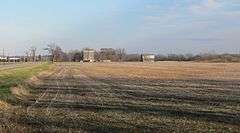Grand Village of the Illinois
|
Old Kaskaskia Village | |
|
Old Kaskaskia Village site, seen from the west. In the background left of center is the Sulphur Springs Hotel. The Illinois River is about 1,000 feet (300 m) south (right) of the road at left. | |
| Nearest city | Ottawa, Illinois |
|---|---|
| Built | 1673 |
| NRHP Reference # | 66000324 |
| Significant dates | |
| Added to NRHP | October 15, 1966[1] |
| Designated NHL | July 19, 1964[2] |
The Grand Village of the Illinois, also called Old Kaskaskia Village, is a site significant for being the best documented historic Native American village in the Illinois River valley. It was a large agricultural village of Native Americans of the Illini confederacy, located on the north bank of the Illinois River near the present town of Utica, Illinois.
French explorers Louis Joliet and Father Jacques Marquette came across it in 1673. The Kaskaskia, a tribe of the Illiniwek people (and later, other Illiniwek tribes) lived in the village. It grew rapidly after a mission and fur trading post were established there in 1675, to a population of about 6,000 people in about 460 houses.[3] Around 1691 the Kaskaskia and other Illiniwek moved further south, abandoning the site due to pressure from an Iroquois invasion from the northeast.[3]
The historic site is owned by the U.S. state of Illinois. The state has conducted archaeological excavations there. The site was declared a National Historic Landmark in 1964.[2]
A prominent local landmark, Starved Rock, stands on the south bank of the river directly opposite the Grand Village site. Explorer La Salle founded a fort there to be near this village. Starved Rock is also a National Historic Landmark and is included in Starved Rock State Park.
History
Archeological evidence indicates that the Illini of the Grand Village were well adapted to their environment. They grew corn, beans, and squash in the rich alluvial soil. In 1673, Father Jacques Marquette and Louis Joliet visited the village, which at that time contained approximately 1,000 people. The French were returning from their expedition to chart the Mississippi River. Although terminally ill, Marquette returned to the Grand Village in early 1675 to celebrate Mass, and found the mission of the Immaculate Conception of the Blessed Virgin.[4][5] The French called the village both the Grand Village of the Kaskaskia and La Vantum.
The Native Americans of the Eastern Woodland culture were severely affected by epidemic infectious diseases brought to North America from Europe, as they had no natural immunity. In addition, the introduction of guns increased the fatalities in intertribal conflicts. The fur trade became a source of competition and conflict between tribes. Members of the Illini Confederacy appear to have responded to increasing pressures by banding together. Reports from La Salle and others in the 1680s indicate that the Grand Village of the Illini temporarily increased in size during that decade to 400 cabins housing as many as 6,000 people. This village proved to be unsustainable in size. La Salle and Henri de Tonti also established Fort Saint Louis on the butte now called Starved Rock across the river, where a village near the rock's base called Hotel Plaza developed.
The inhabitants of the Grand Village largely dispersed under pressure from invading Iroquois bands (see, Beaver Wars). Many likely moved to the regions around Peoria (see, Fort Pimiteoui), Cahokia, and Kaskaskia, Illinois. These three towns were named after constituent tribes of the Illinois Confederacy.
Folklore
The European pioneers did not have a clear idea what had happened to the people of the Grand Village. After the villagers dispersed, a tale was repeated in local folklore that members of the Illini Confederacy had been pinned by tribal enemies to a last stand atop Starved Rock. Hopelessly surrounded, the brave villagers refused to surrender and supposedly perished of starvation. It was said that this was how "Starved Rock" got its name.
Tonti
In one tale, attributed to the French and Indians, the explorer Henri de Tonti cached a hoard of gold on or near the canyons and bluffs of Starved Rock to secrete it from a French Canadian governor who had dismissed him. Later in 1704 when he was dying of yellow fever, Tonti described the treasure's location to the priest who was giving him last rites. As the story goes, the priest mentioned this revelation to third parties, but did not describe the secret location, and this key piece of information was lost when the priest died in an Illinois River canoe accident.
Pontiac
Another narrative centers on the death, in 1769, of Pontiac at the hands of an unnamed member of the Illini Confederacy. According to this story, the Pottawatomi, who were closely allied to Pontiac's kinfolk, made war on the Illini, forcing many of them to take refuge on the bluff that would become known as "Starved Rock." The Illini supposedly starved as their blufftop refuge was besieged.
Today
The site of the Grand Village of the Illinois was acquired by the state of Illinois in 1991 as a non-operating site of the Illinois Historic Preservation Agency. As of 2012, it is not open to the public.
See also
- List of archaeological sites on the National Register of Historic Places in Illinois
- Kolmer Site, another Illiniwek village
References
- ↑ National Park Service (2007-01-23). "National Register Information System". National Register of Historic Places. National Park Service.
- 1 2 "Old Kaskaskia Village". National Historic Landmark summary listing. National Park Service. Retrieved 2007-10-12.
- 1 2 "Old Kaskaskia Village Site". Survey of Historic Sites and Buildings. National Park Service. 2005-03-22. Retrieved 2007-10-13.
- ↑ http://www.historymuseum.ca/virtual-museum-of-new-france/the-explorers/jacques-marquette-1673-1694/
- ↑ http://www.museum.state.il.us/muslink/nat_amer/post/htmls/soc_french.html
